-
LMV60x 1-MHz, Low-Power, General-Purpose, 2.7-V Operational Amplifiers
- 1 Features
- 2 Applications
- 3 Description
- 4 Revision History
- 5 Pin Configuration and Functions
-
6 Specifications
- 6.1 Absolute Maximum Ratings
- 6.2 ESD Ratings
- 6.3 Recommended Operating Conditions
- 6.4 Thermal Information
- 6.5 Electrical Characteristics - DC (2.7 V)
- 6.6 Electrical Characteristics - AC (2.7 V)
- 6.7 Electrical Characteristics - DC (5 V)
- 6.8 Electrical Characteristics - AC (5 V)
- 6.9 Typical Characteristics
- 7 Detailed Description
- 8 Application and Implementation
- 9 Power Supply Recommendations
- 10Layout
- 11Device and Documentation Support
- 12Mechanical, Packaging, and Orderable Information
- IMPORTANT NOTICE
パッケージ・オプション
メカニカル・データ(パッケージ|ピン)
サーマルパッド・メカニカル・データ
発注情報
LMV60x 1-MHz, Low-Power, General-Purpose, 2.7-V Operational Amplifiers
1 Features
- Typical 2.7-V Supply Values; Unless Otherwise Noted
- Ensured 2.7-V and 5-V Specifications
- Supply Current (Per Amplifier): 100 µA
- Gain Bandwidth Product: 1 MHz
- Shutdown Current (LMV601): 45 pA
- Turnon Time from Shutdown (LMV601): 5 µs
- Input Bias Current: 20 fA
2 Applications
- Cordless and Cellular Phones
- Laptops
- PDAs
- PCMCIA and Audio
- Portable and Battery-Powered Electronic Equipment
- Supply Current Monitoring
- Battery Monitoring
- Buffers
- Filters
- Drivers
3 Description
The LMV60x devices are single, dual, and quad low-voltage, low-power operational amplifiers. They are designed specifically for low-voltage, general-purpose applications. Other important product characteristics are low input bias current, rail-to-rail output, and wide temperature range. The LMV60x have 29-nV voltage noise at 10 KHz, 1-MHz GBW, 1-V/µs slew rate, 0.25-mV Vos. The LMV60x operates from a single supply voltage as low as 2.7 V, while drawing 100-µA (typical) quiescent current. In shutdown mode, the current can be reduced to 45 pA.
The industrial-plus temperature range of −40°C to 125°C allows the LMV60x to accommodate a broad range of extended environment applications.
The LMV601 offers a shutdown pin that can be used to disable the device. Once in shutdown mode, the supply current is reduced to 45 pA (typical).
The LMV601 is offered in the tiny 6-pin SC70 package, the LMV602 in space-saving 8-pin VSSOP and SOIC, and the LMV604 in 14-pin TSSOP and SOIC. These small package amplifiers offer an ideal solution for applications requiring minimum PCB footprint. Applications with area constrained printed-circuit board requirements include portable and battery-operated electronics.
Device Information(1)
| PART NUMBER | PACKAGE | BODY SIZE (NOM) |
|---|---|---|
| LMV601 | SC70 (6) | 2.00 mm × 1.25 mm |
| LMV602 | SOIC (8) | 4.90 mm × 3.91 mm |
| VSSOP (8) | 3.00 mm × 3.00 mm | |
| LMV604 | SOIC (8) | 4.90 mm × 3.91 mm |
| TSSOP (14) | 5.00 mm × 4.40 mm |
- For all available packages, see the orderable addendum at the end of the data sheet.
Sample and Hold Circuit
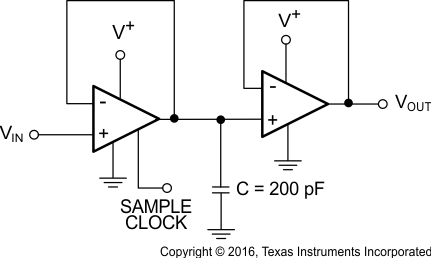
4 Revision History
Changes from B Revision (March 2013) to C Revision
- Added ESD Ratings table, Feature Description section, Device Functional Modes, Application and Implementation section, Power Supply Recommendations section, Layout section, Device and Documentation Support section, and Mechanical, Packaging, and Orderable Information section Go
- Changed Thermal Information table to align with JEDEC standardsGo
- Changed ON mode (LMV601) typical value for VSD in Electrical Characteristics – DC (2.7 V) from '1.7 to 2.7' to '1.7'Go
- Changed ON Mode (LMV601) max value for VSD in Electrical Characteristics – DC (2.7 V) from '2.4 to 2.7' to '2.7'Go
- Changed Shutdown mode (LMV601) typical value for VSD in Electrical Characteristics – DC (2.7 V) from '0 to 1' to '0'Go
- Changed Shutdown mode (LMV601) max value for VSD in Electrical Characteristics – DC (2.7 V) from '0 to 0.8' to '0.8'Go
- Deleted '–0.2 to 4.2 (Range)' from VCM in Electrical Characteristics – DC (5 V)Go
- Changed ON mode (LMV601) typical value for VSD in Electrical Characteristics – DC (5 V) from '3.1 to 5' to '3.1'Go
- Changed ON mode (LMV601) max value for VSD in Electrical Characteristics – DC (5 V) from '4.5 to 5' to '5'Go
- Changed Shutdown mode (LMV601) typical value for VSD in Electrical Characteristics – DC (5 V) from '0 to 1' to '1'Go
- Changed Shutdown mode (LMV601) max value for VSD in Electrical Characteristics – DC (5 V) from '0 to 0.8' to '0.8'Go
Changes from A Revision (March 2012) to B Revision
- Changed layout of National Data Sheet to TI formatGo
5 Pin Configuration and Functions
DCK Package

Pin Functions: LMV601
| PIN | I/O | DESCRIPTION | |
|---|---|---|---|
| NAME | NO. | ||
| GND | 2 | P | Supply negative input |
| +IN | 1 | I | Noninverting input |
| –IN | 3 | I | Inverting input |
| OUT | 4 | O | Output |
| SHDN | 5 | I | Active low enable input |
| V+ | 6 | P | Positive supply input |
DGK or D Packages

PW or D Packages

Pin Functions: LMV602, LMV604
| PIN | I/O | DESCRIPTION | ||
|---|---|---|---|---|
| NAME | NO. | |||
| LMV602 | LMV604 | |||
| +INA | 3 | 3 | I | Noninverting input, channel A |
| +INB | 5 | 5 | I | Noninverting input, channel B |
| +INC | — | 10 | I | Noninverting input, channel C |
| +IND | — | 12 | I | Noninverting input, channel D |
| –INA | 2 | 2 | I | Inverting input, channel A |
| –INB | 6 | 6 | I | Inverting input, channel B |
| –INC | — | 9 | I | Inverting input, channel C |
| –IND | — | 13 | I | Inverting input, channel D |
| OUTA | 1 | 1 | O | Output, channel A |
| OUTB | 7 | 7 | O | Output, channel B |
| OUTC | — | 8 | O | Output, channel C |
| OUTD | — | 14 | O | Output, channel D |
| V+ | 8 | 4 | P | Positive (highest) power supply |
| V– | 4 | 11 | P | Negative (lowest) power supply |
6 Specifications
6.1 Absolute Maximum Ratings
over operating free-air temperature range (unless otherwise noted)(1)(2)| MIN | MAX | UNIT | |||
|---|---|---|---|---|---|
| Differential input voltage | ±Supply Voltage | ||||
| Supply voltage, (V+) – (V–) | 6 | V | |||
| Output short circuit to V+ | See(3) | ||||
| Output short circuit to V– | See(4) | ||||
| Junction temperature, TJ(5) | 150 | °C | |||
| Storage temperature, Tstg | –65 | 150 | °C | ||
6.2 ESD Ratings
| VALUE | UNIT | |||
|---|---|---|---|---|
| V(ESD) | Electrostatic discharge | Human-body model (HBM)(1)(1) | ±2000 | V |
| Machine model (MM)(2) | ±200 | |||
6.3 Recommended Operating Conditions
over operating free-air temperature range (unless otherwise noted)| MIN | MAX | UNIT | ||
|---|---|---|---|---|
| Supply voltage | 2.7 | 5.5 | V | |
| Temperature | –40 | 125 | °C | |
6.4 Thermal Information
| THERMAL METRIC(1) | LMV601 | LMV602 | LMV604 | UNIT | |||
|---|---|---|---|---|---|---|---|
| DCK (SC70) |
D (SOIC) |
DGK (VSSOP) |
D (SOIC) |
PW (TSSOP) |
|||
| 6 PINS | 8 PINS | 8 PINS | 14 PINS | 14 PINS | |||
| RθJA | Junction-to-ambient thermal resistance | 229.1 | 120.8 | 178.3 | 91.5 | 123.8 | °C/W |
| RθJC(top) | Junction-to-case (top) thermal resistance | 116.1 | 65.2 | 68.4 | 49.7 | 50.5 | °C/W |
| RθJB | Junction-to-board thermal resistance | 53.3 | 61.4 | 98.8 | 46 | 66.2 | °C/W |
| ψJT | Junction-to-top characterization parameter | 8.8 | 16.1 | 9.8 | 12.4 | 6.3 | °C/W |
| ψJB | Junction-to-board characterization parameter | 52.7 | 60.8 | 97.3 | 45.7 | 65.6 | °C/W |
6.5 Electrical Characteristics – DC (2.7 V)
Unless otherwise specified, all limits ensured for TJ = 25°C, V+ = 2.7 V, V− = 0 V, VCM = V+ / 2, VO = V+ / 2 and RL > 1 MΩ.(1)6.6 Electrical Characteristics – AC (2.7 V)
Unless otherwise specified, all limits ensured for TJ = 25°C, V+ = 2.7 V, V− = 0 V, VCM = V+ / 2, VO = V+ / 2 and RL > 1 MΩ.(1)| PARAMETER | TEST CONDITIONS | MIN | TYP | MAX | UNIT | |
|---|---|---|---|---|---|---|
| SR | Slew rate | RL = 10 kΩ,(2) | 1 | V/µs | ||
| GBW | Gain bandwidth product | RL = 100 kΩ, CL = 200 pF | 1 | MHz | ||
| Φm | Phase margin | RL = 100 kΩ | 72 | deg | ||
| Gm | Gain margin | RL = 100 kΩ | 20 | dB | ||
| en | Input-referred voltage noise | f = 1 kHz | 40 | nV/√Hz | ||
| in | Input-referred current noise | f = 1 kHz | 0.001 | pA/√Hz | ||
| THD | Total harmonic distortion | f = 1 kHz, AV = 1 RL = 600 Ω, VIN = 1 VPP |
0.017% | |||
6.7 Electrical Characteristics – DC (5 V)
over operating free-air temperature range (unless otherwise noted)(1)| PARAMETER | TEST CONDITIONS | MIN | TYP | MAX | UNIT | ||
|---|---|---|---|---|---|---|---|
| VOS | Input offset voltage | LMV601 | 0.25 | 4 | mV | ||
| LMV602 and LMV604 | 0.7 | 5 | |||||
| TCVOS | Input offset voltage average drift | 1.9 | µV/°C | ||||
| IB | Input bias current | 0.02 | pA | ||||
| IOS | Input offset current | 6.6 | fA | ||||
| IS | Supply current | Per amplifier | 107 | 200 | µA | ||
| Shutdown mode, VSD = 0 V (LMV601) | 0.033 | 1 | µA | ||||
| CMRR | Common-mode rejection ratio | 0 V ≤ VCM ≤ 4 V | 86 | dB | |||
| PSRR | Power supply rejection ratio | 2.7 V ≤ V+ ≤ 5 V | 82 | dB | |||
| VCM | Input common-mode voltage | For CMRR ≥ 50 dB | 0 | 4 | V | ||
| AV | Large signal voltage gain(2) | RL = 10 kΩ to 2.5 V | 116 | dB | |||
| VO | Output swing | RL = 10 kΩ to 2.5 V | Swing high | 7 | 30 | mV | |
| Swing low | 30 | 7 | |||||
| IO | Output short-circuit current | Sourcing | 113 | mA | |||
| Sinking | 75 | ||||||
| ton | Turnon time from shutdown | (LMV601) | 5 | µs | |||
| VSD | Shutdown pin voltage range | ON mode (LMV601) | 3.1 | 5 | V | ||
| Shutdown mode (LMV601) | 0 | 0.8 | |||||
6.8 Electrical Characteristics – AC (5 V)
Unless otherwise specified, all limits ensured for TJ = 25°C, V+ = 5 V, V− = 0 V, VCM = V+ / 2, VO = V+ / 2 and RL > 1 MΩ.| PARAMETER | TEST CONDITIONS | MIN | TYP | MAX | UNIT | |
|---|---|---|---|---|---|---|
| SR | Slew rate | RL = 10 kΩ,(1) | 1 | V/µs | ||
| GBW | Gain bandwidth product | RL = 100 kΩ, CL = 200 pF | 1 | MHz | ||
| Φm | Phase margin | RL = 100 kΩ | 72 | ° | ||
| Gm | Gain margin | RL = 100 kΩ | 20 | dB | ||
| en | Input-referred voltage noise | f = 1 kHz | 39 | nV/√Hz | ||
| in | Input-referred current noise | f = 1 kHz | 0.001 | pA/√Hz | ||
| THD | Total harmonic distortion | f = 1 kHz, AV = 1 RL = 600 Ω, VIN = 1 VPP |
0.012% | |||
6.9 Typical Characteristics
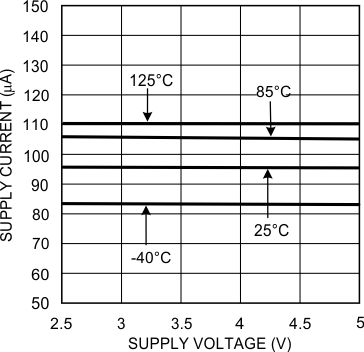 Figure 1. Supply Current vs Supply Voltage (LMV601)
Figure 1. Supply Current vs Supply Voltage (LMV601)
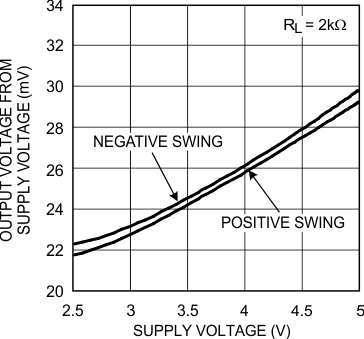 Figure 3. Output Voltage Swing vs Supply Voltage
Figure 3. Output Voltage Swing vs Supply Voltage
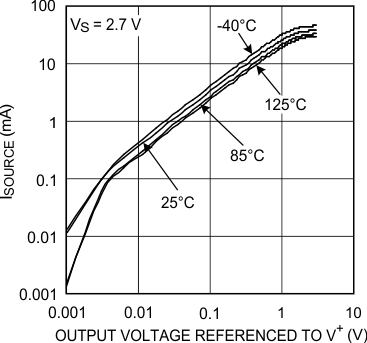 Figure 5. ISOURCE vs VOUT
Figure 5. ISOURCE vs VOUT
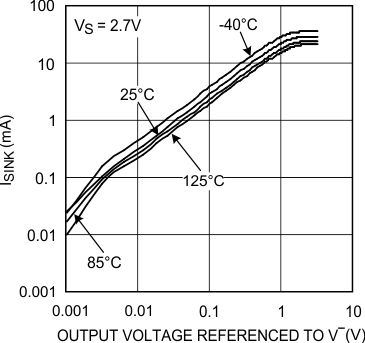 Figure 7. ISINK vs VOUT
Figure 7. ISINK vs VOUT
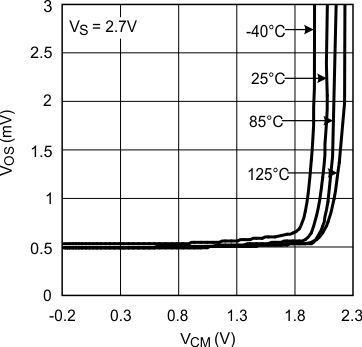 Figure 9. VOS vs VCM
Figure 9. VOS vs VCM
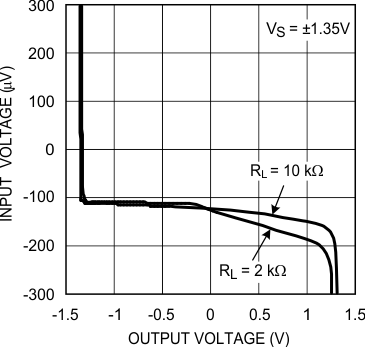 Figure 11. VIN vs VOUT
Figure 11. VIN vs VOUT
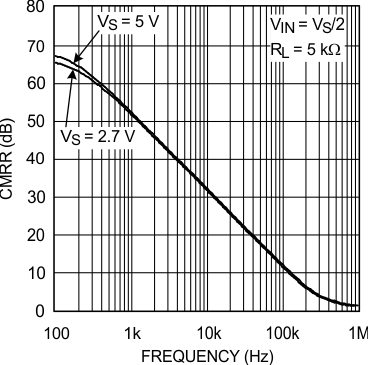 Figure 13. CMRR vs Frequency
Figure 13. CMRR vs Frequency
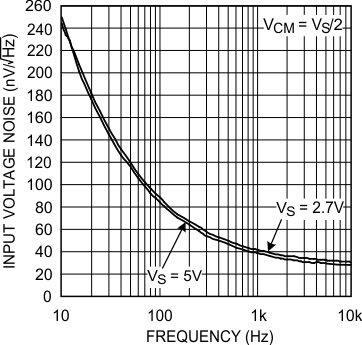 Figure 15. Input Voltage Noise vs Frequency
Figure 15. Input Voltage Noise vs Frequency
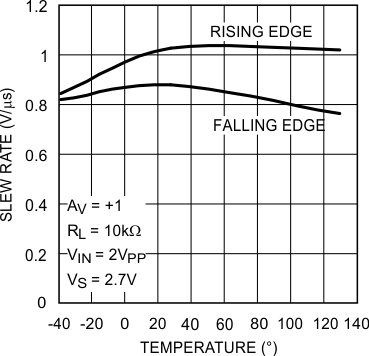 Figure 17. Slew Rate vs Temperature
Figure 17. Slew Rate vs Temperature
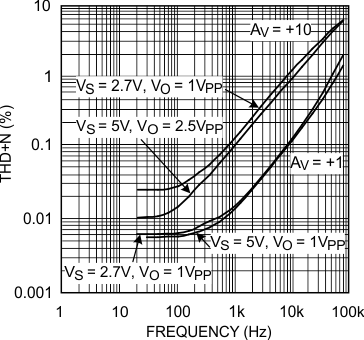 Figure 19. THD+N vs Frequency
Figure 19. THD+N vs Frequency
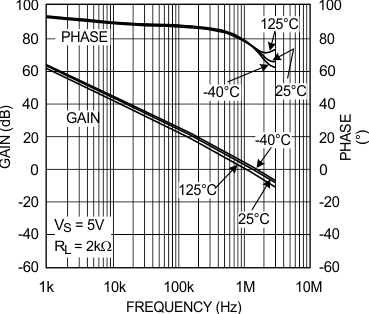 Figure 21. Open-Loop Frequency Over Temperature
Figure 21. Open-Loop Frequency Over Temperature
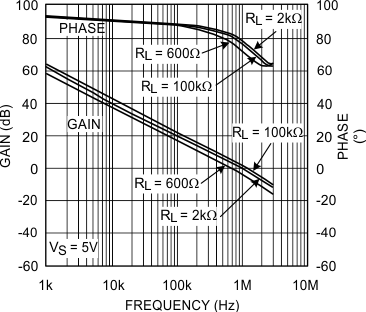 Figure 23. Open-Loop Frequency Response
Figure 23. Open-Loop Frequency Response
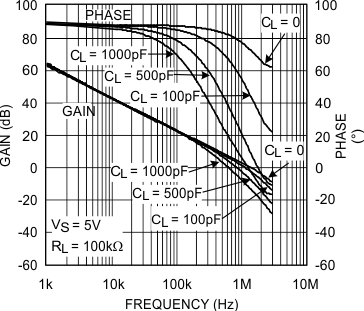 Figure 25. Gain and Phase vs CL
Figure 25. Gain and Phase vs CL
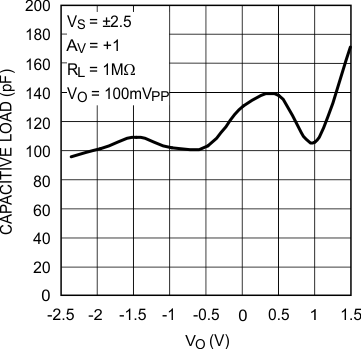 Figure 27. Stability vs Capacitive Load
Figure 27. Stability vs Capacitive Load
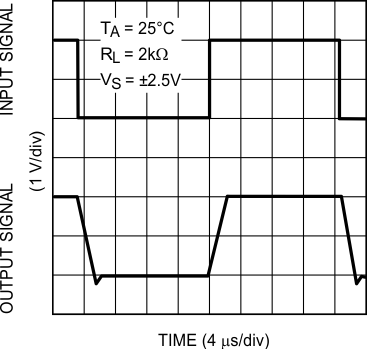 Figure 29. Noninverting Large Signal Pulse Response
Figure 29. Noninverting Large Signal Pulse Response
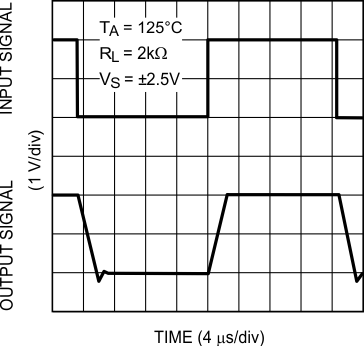 Figure 31. Noninverting Large Signal Pulse Response
Figure 31. Noninverting Large Signal Pulse Response
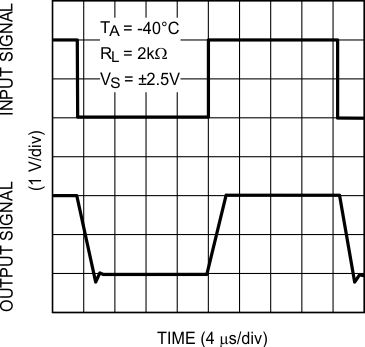 Figure 33. Noninverting Large Signal Pulse Response
Figure 33. Noninverting Large Signal Pulse Response
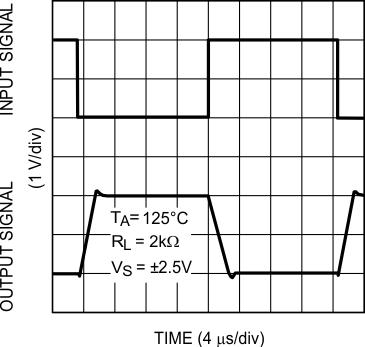 Figure 35. Inverting Large Signal Pulse Response
Figure 35. Inverting Large Signal Pulse Response
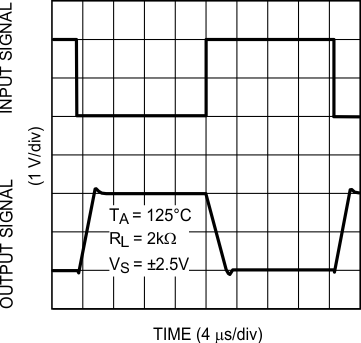 Figure 37. Inverting Large Signal Pulse Response
Figure 37. Inverting Large Signal Pulse Response
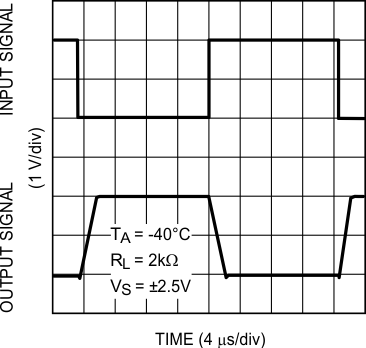 Figure 39. Inverting Large Signal Pulse Response
Figure 39. Inverting Large Signal Pulse Response
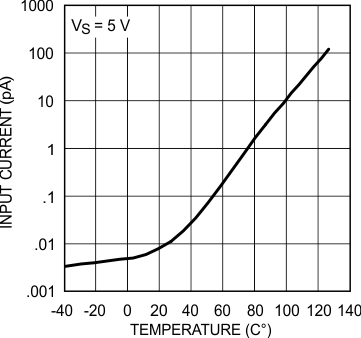 Figure 2. Input Current vs Temperature
Figure 2. Input Current vs Temperature
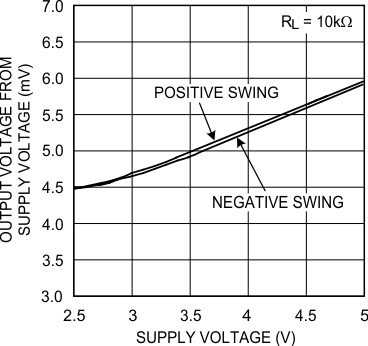 Figure 4. Output Voltage Swing vs Supply Voltage
Figure 4. Output Voltage Swing vs Supply Voltage
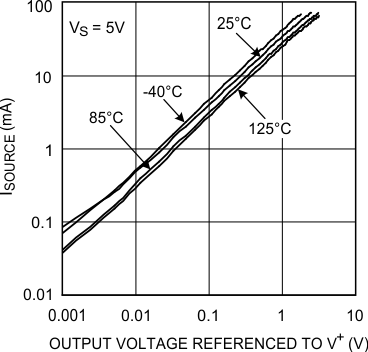 Figure 6. ISOURCE vs VOUT
Figure 6. ISOURCE vs VOUT
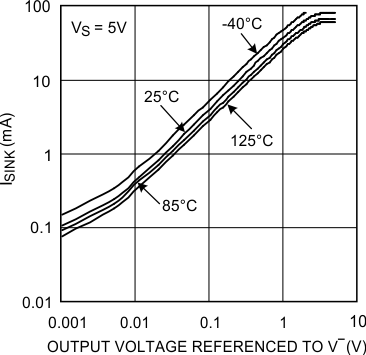 Figure 8. ISINK vs VOUT
Figure 8. ISINK vs VOUT
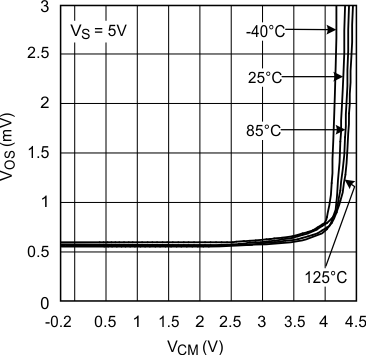 Figure 10. VOS vs VCM
Figure 10. VOS vs VCM
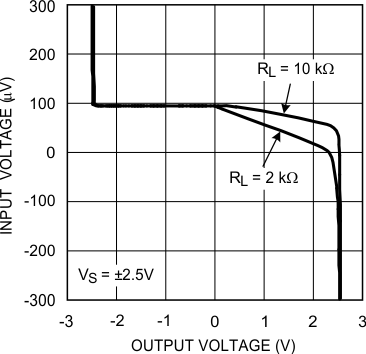 Figure 12. VIN vs VOUT
Figure 12. VIN vs VOUT
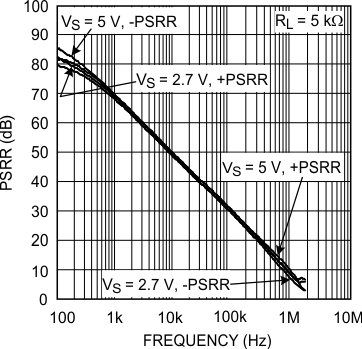 Figure 14. PSRR vs Frequency
Figure 14. PSRR vs Frequency
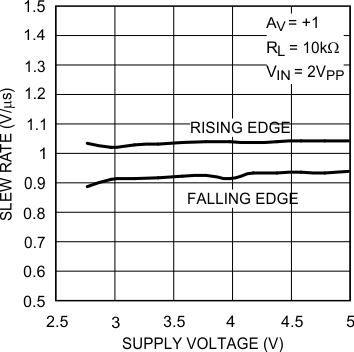 Figure 16. Slew Rate vs VSUPPLY
Figure 16. Slew Rate vs VSUPPLY
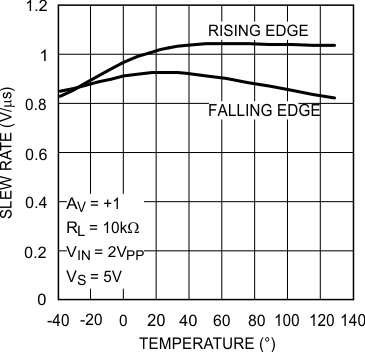 Figure 18. Slew Rate vs Temperature
Figure 18. Slew Rate vs Temperature
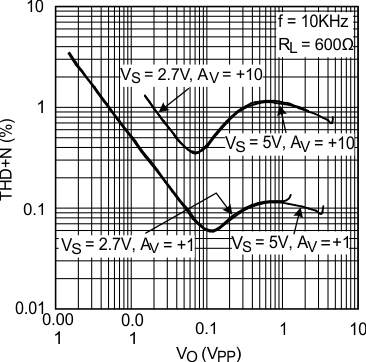 Figure 20. THD+N vs VOUT
Figure 20. THD+N vs VOUT
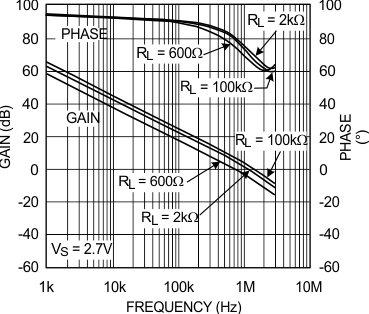 Figure 22. Open-Loop Frequency Response
Figure 22. Open-Loop Frequency Response
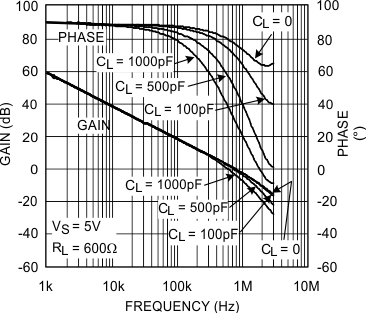 Figure 24. Gain and Phase vs CL
Figure 24. Gain and Phase vs CL
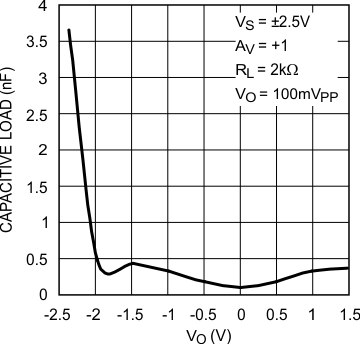 Figure 26. Stability vs Capacitive Load
Figure 26. Stability vs Capacitive Load
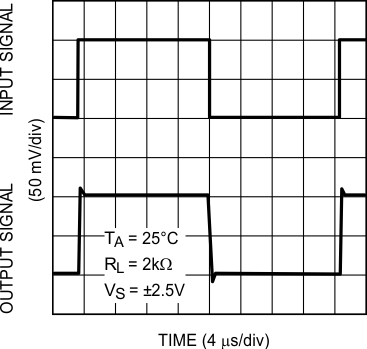 Figure 28. Noninverting Small Signal Pulse Response
Figure 28. Noninverting Small Signal Pulse Response
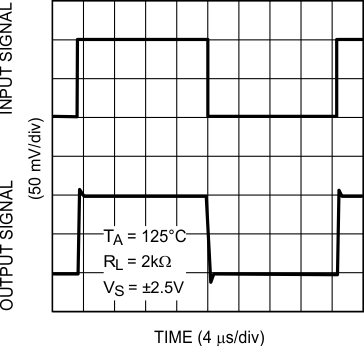 Figure 30. Noninverting Small Signal Pulse Response
Figure 30. Noninverting Small Signal Pulse Response
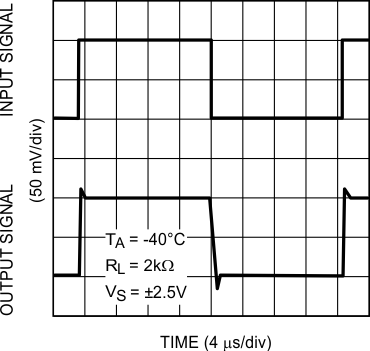 Figure 32. Noninverting Small Signal Pulse Response
Figure 32. Noninverting Small Signal Pulse Response
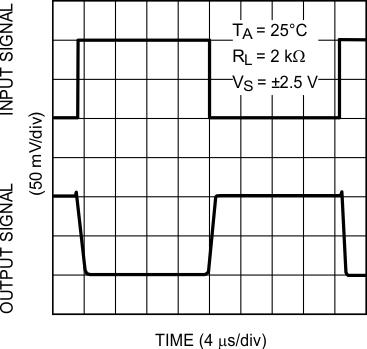 Figure 34. Inverting Small Signal Pulse Response
Figure 34. Inverting Small Signal Pulse Response
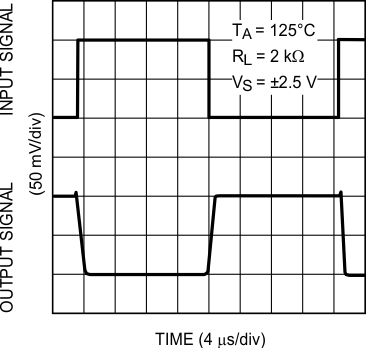 Figure 36. Inverting Small Signal Pulse Response
Figure 36. Inverting Small Signal Pulse Response
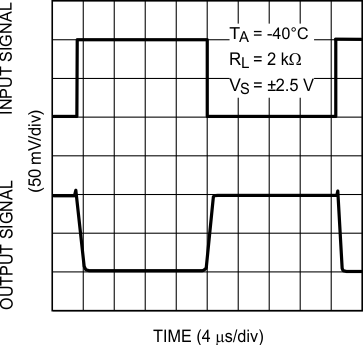 Figure 38. Inverting Small Signal Pulse Response
Figure 38. Inverting Small Signal Pulse Response
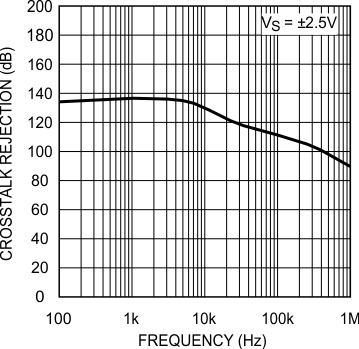 Figure 40. Crosstalk Rejection vs Frequency
Figure 40. Crosstalk Rejection vs Frequency